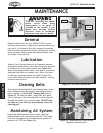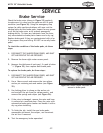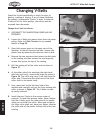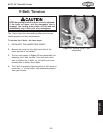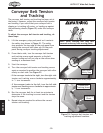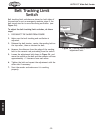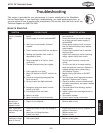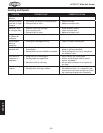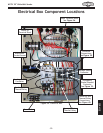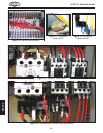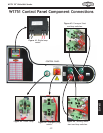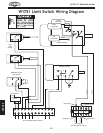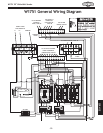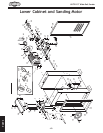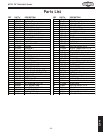
-34-
W1751 25" Wide-Belt Sander
SERVICE
Sanding and Results
SYMPTOM POSSIBLE CAUSE CORRECTIVE ACTION
Edges of wood are
rounded.
1. Excessive depth of cut. 1. Reduce depth of cut.
Uneven thickness
from left to right
of board.
1. Feed table not parallel to sanding roller.
2. Conveyor belt is worn.
1. Adjust the table.
2. Replace conveyor belt.
Workpiece slips
on conveyor belt.
1. Pressure rollers set too high.
2. Dirty conveyor belt.
3. Conveyor belt is worn.
1. Lower pressure rollers.
2. Clean conveyor belt.
3. Replace conveyor belt.
Straight strip
of notches on
workpiece.
1. Pressure rollers are dirty or damaged. 1. Clean or repair pressure rollers.
Snake-shaped
marks on
workpiece.
1. Sanding belt damaged or dirty. 1. Clean or replace sanding belt.
Sandpaper quickly
becomes dull.
1. Sanding belt has been stored in a damp
environment.
2. Sanding belt has been folded or smashed.
1. Store sanding belt away from extremely
damp or wet environments.
2. Store sanding belt on end or hang them,
not folded or bent.
Burn marks on
workpiece or
sandpaper.
1. Using too fine of sanding grit.
2. Sanding depth too aggressive.
3. Work held still for too long.
1. Use a coarser grit sanding belt
2. Reduce sanding depth and/or install
coarser sandpaper.
3. Do not keep workpiece in one place for
too long.
Glazed sanding
surfaces.
1. Sanding wet stock.
2. Sanding stock with high residue.
1. Dry stock properly before sanding.
2. Use different stock. Or, accept the char-
acteristics of the stock and plan on clean-
ing/replacing sanding belts frequently.



